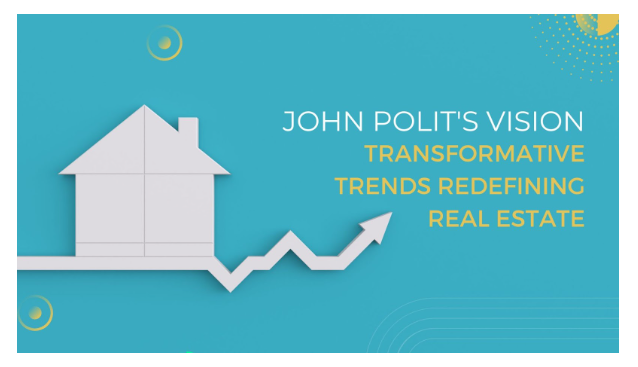John Polit’s Vision: Transformative Trends Redefining Real Estate
The real estate development industry is undergoing significant transformation, fueled by technological advancements and shifting consumer preferences. In today’s dynamic market, there is a growing demand for innovative solutions that prioritize sustainability, smart technology, and community-oriented design. As developers adapt to these changes, they increase property value and improve the overall quality of life for residents. Accepting innovation has become critical for remaining competitive and meeting the diverse needs of modern communities.
1. Sustainable Building Practices
The primary objective of sustainable building methods is to create structures with the least amount of negative environmental impact and the greatest possible resource efficiency. This strategy’s primary goal is to reduce waste and energy consumption by using eco-friendly materials and designs. A healthier planet benefits from lower operating costs, improved indoor air quality, and a smaller carbon footprint.
Developers like John Polit are leading the way by adopting green building certifications, such as LEED, which recognize buildings that meet strict environmental standards. Other certifications, including BREEAM (Building Research Establishment Environmental Assessment Method) and Energy Star, encourage developers to adopt sustainable practices and improve the overall sustainability of real estate projects.
2. Smart Technology Integration
The real estate industry is undergoing a revolution thanks to the integration of smart home technology. This includes remote-controllable gadgets like security cameras, lighting controls, and smart thermostats that are compatible with smartphones. With the help of the Internet of Things (IoT), homeowners can monitor and control their energy consumption, which reduces utility costs and improves energy efficiency.
Smart locks and remote surveillance are two more ways that IoT enhances security. These technologies are being incorporated into new developments more frequently, giving residents increased convenience, safety, and energy savings. As a result, properties become more appealing in today’s competitive market.
3. Modular and Prefabricated Construction
In modular construction, buildings are constructed in sections, or “modules,” in a factory and then assembled and transported to the construction site. The ability to build modules concurrently with site preparation is one of the many benefits of this method, which also leads to quicker construction times. It is also cost-effective, often resulting in lower labor and material costs. Additionally, modular construction significantly reduces waste, as precise factory production minimizes excess materials.
4. Mixed-use developments
Mixed-use developments combine residential, commercial, and recreational spaces within a single area, creating vibrant communities where people can live, work, and play. These environments promote convenience and accessibility, reducing the need for long commutes and fostering a sense of community. Benefits include enhanced social interaction, increased foot traffic for local businesses, and improved overall quality of life.
5. Urban Revitalization and Adaptive Reuse
Urban revitalization is essential for maintaining the character and functionality of communities by repurposing existing structures. This approach, championed by experts like John Polit, helps preserve historical significance and cultural heritage while minimizing environmental impact through reduced waste.
Adaptive reuse can provide economic benefits, such as lower construction costs and increased property values. Successful case studies include the transformation of factories into residential lofts and the conversion of old schools into community centers, demonstrating how adaptive reuse can effectively balance modern needs with historical preservation in urban environments.
6. Focus on Community and Lifestyle
There has been a significant shift toward community-oriented developments that enhance residents’ lifestyles. Developers are increasingly prioritizing walkability, allowing individuals to easily access shops, parks, and public transportation, which encourages a more active way of living. Green spaces are also essential, providing areas for recreation and relaxation that contribute to overall well-being.
Furthermore, the inclusion of amenities such as fitness centers, communal gathering areas, and cafés fosters social interaction among residents, enhancing their sense of belonging. These trends reflect a growing recognition of the importance of creating environments that not only meet housing needs but also promote community engagement and improve the overall quality of life for individuals and families.
7. Digital Transformation and Real Estate Tech
Digital transformation is revolutionizing the real estate industry, primarily through proptech (property technology). Proptech encompasses various tools and platforms that enhance property management, investment, and sales processes. Virtual reality (VR) and augmented reality (AR) are significant advancements in property marketing, allowing potential buyers to experience properties through immersive virtual tours and interactive visuals, making the decision-making process more engaging and efficient.
Furthermore, the utilization of big data and artificial intelligence (AI) is revolutionising the process of making real estate decisions by offering significant perspectives into consumer behavior, market trends, and investment prospects. With the use of these technologies, developers and investors can optimize their strategies and reduce risks by making data-driven decisions. Ultimately, operations are being streamlined and the real estate experience is being improved for all parties involved by the integration of proptech, VR, AR, big data, and AI.
OutCome
John Polit recognizes that new trends in real estate development are focusing on sustainability, technology, and community involvement. From smart technology and modular construction to adaptive reuse and mixed-use developments, these advancements not only enhance property values but also improve residents’ quality of life. By embracing these trends, developers can create more efficient, livable, and environmentally friendly spaces that meet the evolving needs of modern communities. The continued focus on innovation will be vital for success in the dynamic real estate landscape.

